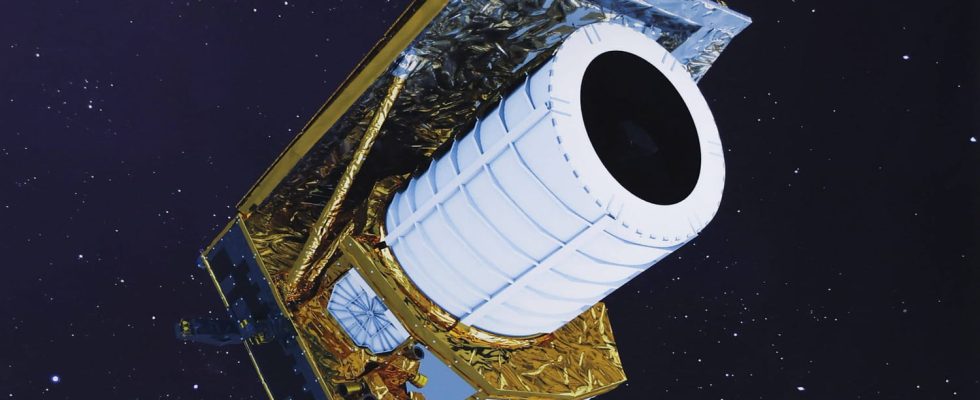EUCLID. The European Space Agency’s Euclid telescope is due to take off this Saturday, July 1, 2023 at the end of the afternoon aboard a SpaceX rocket. Here’s everything you need to know about this ambitious European mission.
One year after James Webb started up, it is the turn of a space telescope from the European Space Agency to take off in the direction of the Lagrange 2 point. Scheduled for this Saturday 1er next July, this launch will take place from the Cape Canaveral base in Florida aboard a Falcon 9 rocket from the company SpaceX by Elon Musk. Several weeks of travel then await the spacecraft, which should be operational next fall.
The objective of this new telescope is to produce a three-dimensional map of theUniverse and to retrace the last billion years of the expansion of the latter. All of this work will serve to understand the role played by black matter and dark energy, two very mysterious elements that scientists struggle to understand other than theoretically. Very different from its James Webb counterpart, this space telescope should be a great tool for better understanding the cosmos.
When is the launch of the Euclid telescope scheduled?
Housed in the fairing of a SpaceX Falcon 9 rocket, the Euclid telescope is due to take off on Saturday 1er July 2023. The launch will take place at 5:11 p.m. (Paris time) from the Cape Canaveral base in Florida. At 5:53 p.m., the launcher will separate from the telescope, which will continue its journey alone. The first signal from Euclid should be picked up from 5:57 p.m. at the earliest.
Where to follow the takeoff of the rocket containing the Euclid telescope?
On the occasion of the takeoff of the Euclid telescope aboard a Falcon 9 rocket from SpaceX, the ESA offers a live. To not miss anything of the show, watch the channel Youtube below from the space agency from 4:30 p.m. on Saturday July 1:
What will the Euclid telescope study?
The Euclid telescope, designed by Thales Alenia Space, should help us understand the nature and functioning of dark matter and dark energy. These two mysterious components constitute 95% of the Universe and remain theoretical elements in the eyes of scientists.
According to the hypotheses established by astronomers, dark matter and dark energy influence the movements and distribution of objects such as stars or galaxies. Euclid’s mission is therefore to establish a three-dimensional map of the Universe and will have to observe billions of galaxies located 10 billion light-years away. Thanks to this map, it will be possible to understand how the expansion of the Universe took place and the role played by dark matter and dark energy in this process.
What instruments equip Euclid?
The European telescope with a diameter of 1.2 meters carries with it two scientific instruments essential to carry out the task entrusted to it. It has an imager capable of observing in visible light called VIS. The latter will make it possible to study the shape of galaxies and to measure them.
The telescope is also equipped with a spectrophotometer sensitive to infrared radiation, called NISP. This instrument will provide information on the luminosity of galaxies and the distance that separates us from them.
Euclid also has a sunshield that protects its instruments from heat since they are designed to operate at -120°C for the VIS and -180°C for the NISP. These two tools must therefore imperatively remain in the shade.

When will Euclid arrive at its destination?
The Euclid telescope should travel for four weeks to reach its final position 1.5 million kilometers from Earth. It will then join the James Webb Space Telescope, orbiting Lagrange Point 2. This is a place where gravitational forces are weak, allowing the instrument to remain stable and save energy for maintain its position.
During its first three months on site, performance tests will be carried out so that scientists can ensure the proper functioning of the various instruments on board the telescope. It is only three months after its launch that Euclid will be able to start collecting data.
How big is the Euclid telescope?
With a height of 4.7 meters high and 3.7 meters in diameter, the machine accommodates a telescope with a diameter of 1.2 meters. Its total weight is two tons, of which 210 kilograms are made up of propellants, that is to say fuel.
How long should the Euclid mission last?
Despite the magnitude of the task, the Euclid mission is scheduled to last only six years. Indeed, the telescope is able to collect a large amount of information on a large area of the sky in a single observation. This is what differentiates it from the James Webb telescope whose instruments are designed to study details and zoom in on small areas. This is how Euclid should succeed in carrying out its cartography in just a few years.
